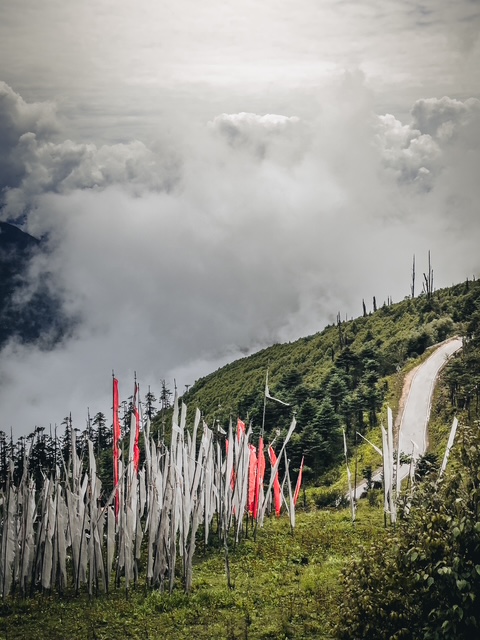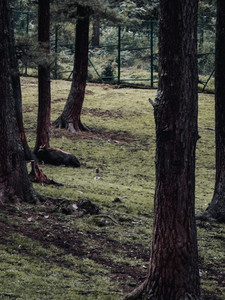Perched on the eastern edge of the Himalayas, this tiny kingdom has always been wrapped in mystique. Bhutan isn’t the easiest country to visit, with limited flights and long drives, but the effort is well worth it. If you're seeking a unique and authentic travel experience filled with tranquility and pristine nature, Bhutan is the perfect destination.

In a world increasingly dominated by globalization and sameness, where cities feature the same stores found worldwide, Bhutan offers a refreshing escape. As the world’s only Buddhist Monarchy, it boasts a long-standing green legacy, making it the first carbon-neutral country on Earth. For an unforgettable journey, explore my guide "Best Places to Visit in Bhutan: A 7-Day Travel Guide" to discover the highlights of this enchanting land.
7 Day ITINERARY FOR BHUTAN
Day 1 Drive from Bagdogra, India to Thimphu, Bhutan
Day 2 Thimphu sight seeing
Day 3 Paro sightseeing
Day 4 Tigers Nest hike - all day
Day 5 Chelala Pass and Haa Valley
Day 6-7 Drive back from Bhutan to Bagdogra
TABLE OF CONTENTS
FLIGHTS + VISA + SDF FEES
The logistics of getting to Bhutan is one of the reasons it has been a well kept secret. Somethings that aren't always shared - there are just three flights that fly into Bhutan, which means that you are willing work around a huge budget, your options of getting to Bhutan are limiting.
If you choose to fly - then fly into Paro on the national carriers Druk or Bhutan Air from Singapore, Delhi, Bangkok, Kathmandu.
If you want to keep costs low, you go via India and cross the border by road. Fly from anywhere in India to Bagdogra, then cross the border. This is a long but scenic journey that can take around 10 hours with stops for lunch and dinner - but you can always sleep through it; which is what we did.
If you hold an Indian passport, the visa is on arrival and free of charge, for most other nationalities the process is simple but comes at an additional cost. There is a small mandatory daily Sustainable Development Fund fee for all travelers coming into Bhutan. This is included in the costs of the tour for Indian passport holders and foreigners. The cost, however, is much higher for foreigners.
LANGUAGE
The official and national language of Bhutan is Dzongkha. It belongs to the Tibeto-Burman language family and is written using the Tibetan script. In the villages, you will have difficulty communicating with locals, but if you are with a guide, no issues at all.
BEST TIME TO VISIT
The best time to visit Bhutan depends on what you're looking for in your trip:
Peak Season (Spring and Autumn):
March to May (Spring): Pleasant weather with blooming rhododendrons, clear skies, and stunning Himalayan views. Ideal for trekking and hiking.
September to November (Autumn): Comfortable temperatures, clear skies, and vibrant
May and November: Less crowded than peak season, with comfortable weather. Perfect for sightseeing and cultural experiences.
June to August (Monsoon): Lush greenery, fewer crowds, and discounted rates. However, be prepared for occasional rain showers (we didn't really encounter any rain in August)
CURRENCY
Bhutanese Ngultrum (BTN) is the primary currency. Here are some key tips:
Indian Rupees are widely accepted in Bhutan, except for ₹2,000 notes.
Cash is essential in Bhutan, especially outside major cities like Thimphu and Paro. Credit and debit cards are accepted only in select high-end hotels, restaurants, and shops.
ATMs are few and far between, and they may not always support international cards.
GUIDE
Did you know that hiring a local guide is mandatory for entry into Bhutan? Beyond the regulatory requirement, engaging a local guide can significantly enhance your travel experience. You'll gain deeper insights into the culture, history, and traditions of this mystical Himalayan kingdom. Plus, you'll directly contribute to the local economy.
Interested in planning your own Bhutan adventure or joining an upcoming group trip? Reach out to me for personalized assistance.
SAFETY
Bhutan is one of the safest countries in the world, and its warm, peaceful environment makes it an excellent destination for solo travelers and women. Women travelers are treated with respect in Bhutan. The culture promotes gender equality, and harassment is virtually unheard of. While Bhutan is liberal compared to some neighboring countries, dressing modestly. Bhutan requires international tourists to travel with a licensed tour operator. This rule ensures that you are always accompanied by a knowledgeable guide, which enhances safety and convenience.

VEGAN + VEGETARIAN FOOD
Bhutan offers a variety of flavorful vegetarian and vegan dishes deeply rooted in its culture and tradition. Some of the dishes to try - Ema Datshi, Kewa Datshi, Shamu Datshi, Puta, Goen Hogey. Don't miss Suja (Butter Tea)!
Highlights
THIMPHU
Our Bhutan trip started in Thimphu. The capital city is a little more commercial than I would have liked but it is still peaceful and a fabulous place to kick start your Bhutanese adventure before venturing into the countryside.

These are the historic places we covered and ones you shouldn’t miss.
📌 The Simtoka Dzong: one of the oldest Dzong’s in Bhutan, this place is a stunner, inside and outside. Mesmerizing details and Buddhist sculptures left is wanting more
📌 Buddha Dordenma Statue: one of the world’s largest and tallest sitting Buddha statues, at over 52m. It’s almost like Buddha is protecting the city and all its inhabitants
📌 Simply Bhutan: a living museum that gives you a glimpse of the Bhutanese culture, and how they still protect their old traditions with gusto. From singing, dancing, to rice wine tasting, it’s absolutely fabulous!
📌 Takin reserve: of course I had to include something with wildlife. The Takin reserve was built as a natural reserve to protect a rare animal called Takin, the national animal of Bhutan. We also found fee other animals inside the park. The forest area is actually gorgeous and lush green.
📌 The view of the double rainbow over Tashichho Dzong. This is an old palace that tells us stories of the glorious past of Bhutan!

📌 Local food: if you are in the mood for great local food that’s veggie friendly, get the ema datshi (chillies with cheese)

PARO
From the commercial Thimphu to Paro, a quaint town, is one of the widest valleys in Bhutan. It is a land of forgotten customs and pristine wilderness. From fortresses to ruins, from sacred monasteries to holy temples, and from soul-quenching treks to picturesque landscapes, Paro has something for all types of travelers!
These are the must-see places:
📌 while driving from Thimphu, travel via Wangchu River - it is an amazingly scenic drive!
📌 Click pictures of the dzongs and Nya Mey Zam bridge at night
📌 Rinpung Dzong aka Paro Dzong occupies a strategic site on the top of a small hill with a panoramic view of the Paro valley around it. It looks like a castle in the air. Dress in Bhutanese National Dress, find the best shop right opposite Paro Dzong!
TIGER'S NEST HIKE
Undoubtedly the most popular place in Bhutan, Paro Taktsang, often referred to as Tiger's Nest, has become almost synonymous with the country itself—and with good reason.

Perched majestically at a breathtaking height of 9,678 feet above sea level, it’s impossible not to fall in love with the picturesque facade of this iconic monastery, which is set against the dramatic backdrop of a steep, leaning cliff.
The stunning views of the surrounding valleys and mountains only add to its allure, making it a must-visit destination for travelers seeking both adventure and spiritual enlightenment. The site is believed to be one of the thirteen Tiger’s Nest caves in Tibet, which adds to its mystique, hence it is best known as Tiger’s Lair caves. This rich history and cultural significance make it a central point of interest for those who wish to explore the deep spiritual roots of Bhutanese Buddhism.
I had lots of questions about how difficult this trail is, as the trek to reach this remarkable destination is often a topic of discussion among visitors. If you are a beginner hiker, the trail can certainly appear daunting at first glance, with its steep inclines and uneven terrain.
However, there is no reason you cannot complete the loop if you approach it with patience and determination. Just take your time, enjoy the journey, and remember that the experience is just as important as the destination. For those who find their fitness level to be above average, the trek can be completed in a brisk 90 to 120 minutes or even less, but it is advisable to pace yourself. Regardless of your fitness level, make sure to leave ample time for rest breaks along the way.
These pauses not only allow you to catch your breath but also provide a wonderful opportunity to soak up all that spiritual energy that permeates the air around you. The serene atmosphere, combined with the breathtaking views, creates a truly enriching experience that will leave a lasting impression on your heart and mind.
PRO TIP: highly recommend doing a Bhutanese stone bath after the trek - so good for those sore muscles!

HAA VALLEY AND CHELELA PASS
True to style, one the last few days from Paro, we went to Chelela Pass and Haa Valley. Routes you won’t find on just any regular trip. I found this after a bit of reading and so happy I did, as we were the only tourists there.
At the dizzying height of 3,988 meters, Chelela Pass feels like the top of the world, it is the highest passes in Bhutan. The prayer flags flutter in the wind, sending blessings across the Himalayas as you take in the sweeping views of the Paro and Haa valleys.

Quaint and deserted, Haa Valley is where the earth kisses the sky, wrapped in blankets of green and dotted with wildflowers. The air here feels different, crisp and pure, untouched by the modern world. It’s a place where nature reigns supreme, offering solace to those who seek peace away from the chaos.
I loved both these places the most during our week long Bhutan trip. It’s incredible to find ancient temples tucked away in corners only the mountains know. This valley is Bhutan’s best-kept secret, an untouched paradise.
FOODIE TIP: if you visit Haa Valley, you have to try “hoentay” which is a buckwheat dumpling stuffed with radish, spinach, cheese and pepper.

FINAL THOUGHTS
Fortress. Green Mountains. Monasteries. Untouched valleys. Traditions & authenticity. These words barely scratch the surface of what it means to embark on a journey through the breathtaking landscapes and rich cultural tapestry of Bhutan. The moment we set foot in this enchanting country, I was captivated by its unique blend of natural beauty and spiritual depth.
Any culture that is deeply rooted in Buddhism has always been fascinating to me, so when the opportunity to head to Bhutan to lead a group trip came by, I knew I had to go for it.

The allure of Bhutan is not just in its picturesque scenery but also in its commitment to preserving its cultural heritage and environment. Add that to the fact that it’s an amazing place for active adventures—from challenging hikes that take you to ancient monasteries perched on cliffs, to exhilarating rafting experiences on pristine rivers, and opportunities for wildlife viewing in lush national parks—I was completely sold!
The experience of being in Bhutan was nothing short of incredible. I was fortunate to spend several days in a land where the air is refreshingly pure, devoid of pollution, and where the sounds of nature take precedence over the noise of modern life. The tranquility and serenity of the environment felt like a much-needed escape from the chaos of everyday existence. It was such a privilege to visit yet another destination frozen in time, unchanged by the whims of mass tourism.
The people of Bhutan, with their warm smiles and welcoming nature, embody the essence of their rich cultural traditions, which remain intact and vibrant against the backdrop of the stunning Himalayan landscape. Each moment spent in this remarkable country was a reminder of the beauty that comes from living in harmony with nature and honoring one's heritage.
Thanks for reading. Leave your questions and comments below.
Lots of love,
Anki












































































I am incredibly pleased to know that here we can talk about the news and discuss any topic at all. In terms of news, I have a high-quality news portal that has been providing me with important, up-to-date and verified information for many years, which is very important today. Thus, I have recently learned that Maxim Krippa and DIM have signed an agreement https://propertyinvestmentsdubai.com/maksym-krippa-and-dim-signed-a-partnership-and-cooperation-agreement-902/, as for me, this is very cool and large-scale, I am very happy for Krippa, he continues his development in the field of real estate. Not much is known about the deal itself, but we can already draw some conclusions, the first being new opportunities for both parties and a promising future, the second being the…